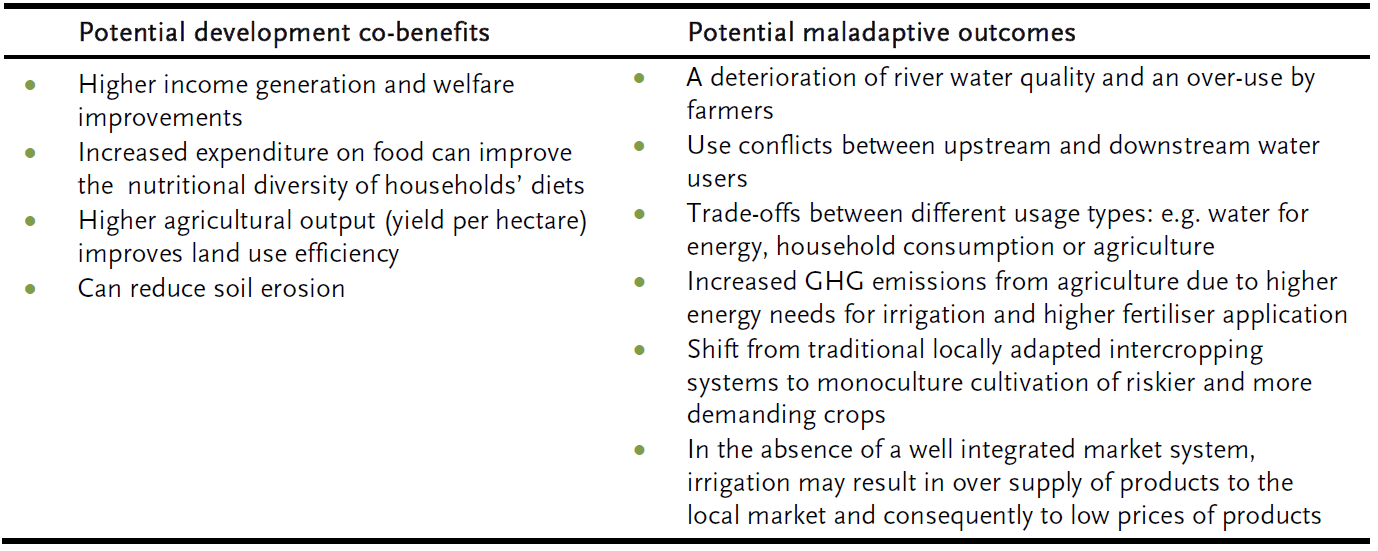Ethiopia: Irrigation
Irrigation can help smallholder farmers to compensate for the negative impacts of erratic and insufficient precipitation and significantly stabilise agricultural production (Woldemariam & Gecho, 2017). More specifically, it can raise agricultural production, allow for greater cropping intensity and crop diversity (i.e. higher-value crops), and lengthen agricultural seasons (Awulachew, 2010; Woldemariam & Gecho, 2017). Irrigation thus serves three main adaptive purposes: 1) Increasing yields by supplying water needed, 2) reducing risk due to a more constant water supply and 3) enabling multiple harvests and cultivation of high-value cash crops, as irrigation supplies water in the dry season.
Currently, irrigation is not wide-spread yet in Ethiopia (estimates range between 2-3 % of agricultural land, with water coming from Ethiopia’s ample surface water resources), with considerable potential to upscale its usage. Stakeholder consultations, interviews, the expert survey conducted and document analysis made clear that irrigation is a key adaptation priority in Ethiopia. The Ethiopian government is aiming to transform its agricultural sector from a subsistence mode to a market-oriented one. The potential for irrigation in Ethiopia is enormous, as it has ample surface water and groundwater resources on the one hand and land suitable for irrigation on the other hand (Woldemariam & Gecho, 2017). Twelve major river basins lie in Ethiopia, which form four main drainage systems. However, there is high spatial and temporal variability (FAO, 2005; Worqlul et al., 2015). According to various studies, there is sufficient water in Ethiopia to develop around 4.5 million hectares of agricultural land that could be irrigated through pump, gravity, pressure, underground water, water harvesting and other mechanisms (Makombe et al., 2011; Woldemariam & Gecho, 2017; Worqlul et al., 2017). The hydrological analysis in Chapter 2 also confirms this and projects ample water available for irrigation in the future.
A cost-benefit analysis of switching from rainfed maize production to irrigated maize production showed that adopting irrigation is beneficial for Ethiopian farmers. Over time, irrigation has a positive return on investment (see Figure 1).

Yet, irrigation requires a considerable investment and only becomes profitable after some years, depending on the type of irrigation system and the farm location. Institutional support is usually required and care has to be taken to avoid potential maladaptive outcomes from irrigation. Table 1 gives an overview of potential co-benefits and maladaptive outcomes from adaptation in Ethiopia.

Constraints to adaptation uptake in Ethiopia include weak institutional capacity and lack of physical infrastructures, such as pumps, conveyance structures and storage facilities, but also access to electricity in rural areas (Awulachew, 2010; FAO, 2015b; Worqlul et al., 2017).
Overall, irrigation is an important adaptation strategy in Ethiopia with large potential to transform the agricultural sector and increase yields. Government support and careful policy design is needed to make implementation succeed.
Note to the reader: This evaluation is only to be viewed as a careful model‐based and expert assessment, which can by no means replace a thorough analysis for specific project design and local implementation planning. It gives an indication of the overall feasibility and suitability of the selected adaptation strategies in Ethiopia. Actual selection of adaptation strategies, however, should always be based on specific needs and interests of local communities.
References
- Awulachew, S. B. (2010). Irrigation potential in Ethiopia Constraints and opportunities for enhancing Irrigation potential in Ethiopia Constraints and opportunities for enhancing the system International Water Management Institute Teklu Erkossa and Regassa E . Namara. IWMI Research Report.
- FAO (UN Food and Agriculture Organization), (2005). Irrigation in Africa in figures – AQUASTAT Survey 2005, 1–14.
- FAO, (2015b): Analysis of price incentives for red sorghum in Ethiopia for the time period 2005-2012. Rome: FAO.
- Makombe, G., Namara, R., Hagos, F., Awulachew, S. B., Ayana, M., & Bossio, D. (2011). A com-parative analysis of the technical efficiency of rain-fed and smallholder irrigation in Ethiopia. IWMI Working Papers (Vol. 143). https://doi.org/10.5337/2011.202.
- Woldemariam, P., & Gecho, Y. (2017). Deter-minants of Small-Scale Irrigation Use: The Case of Boloso Sore District, Wolaita Zone, Southern Ethiopia. American Journal of Agri-culture and Forestry, 5(3), 49.
- Worqlul, A. W., Collick, A. S., Rossiter, D. G., Langan, S., & Steenhuis, T. S. (2015). Assess-ment of surface water irrigation potential in the Ethiopian highlands: The Lake Tana Basin. Catena, 129, 76–85. https://doi.org/10.1016/ j.catena.2015.02.020.
- Worqlul, A. W., Jeong, J., Dile, Y. T., Osorio, J., Schmitter, P., Gerik, T., … Clark, N. (2017). Assessing potential land suitable for surface irrigation using groundwater in Ethiopia. Applied Geography, 85, 1–13.


